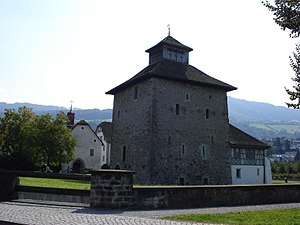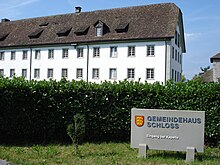Pfäffikon palace complex
| Pfäffikon palace complex | ||
|---|---|---|
|
Pfäffikon Castle Tower |
||
| Alternative name (s): | Pfäffikon Castle Tower, Pfäffikon Castle, Weissenburg | |
| Creation time : | middle of the 13th century | |
| Castle type : | Moated castle | |
| Conservation status: | Receive | |
| Standing position : | clergy | |
| Place: | Pfaffikon | |
| Geographical location | 47 ° 12 '18 " N , 8 ° 46' 24.9" E | |
| Height: | 416 m above sea level M. | |
|
|
||
The Pfäffikon palace complex (formerly Weissenburg ) is located in the immediate vicinity of Lake Zurich in the lower village of Pfäffikon . Today the palace complex is only referred to as the Pfäffikon Castle Tower .
History of the castle complex (castle tower)
In the years 965/72 the German emperors donated the two farms of Pfäffikon and Wollerau to the Einsiedeln monastery . The Benedictine monastery built a storage facility in Pfäffikon to store donations in kind from the population.
In the middle of the 13th century, Abbot Anselm von Schwanden had today's castle tower built to ward off enemy attacks and to protect the income from the monastery lands. Since the complex had to serve repeatedly as an abbot's residence, residential buildings were built near the tower under the direction of Abbot Burkhard von Weissenburg at the beginning of the 15th century. From now on the castle was called the «Weissenburg».
The facility was very important for Einsiedeln Abbey, as the following examples illustrate. The abbot election took place here in 1480, and in 1577 it served the hermit monks as a refuge for 7 months when the monastery and the village of Einsiedeln fell victim to a major fire. The "Weissenburg" also received important visitors again and again, such as various Schwyz bailiffs and governors and the papal nuncio. The palace complex served the monastery as an administrative center until the 18th century and was finally replaced by the baroque governorship that was built next to it.
As a fortification, Pfäffikon Castle was not only under the control of Einsiedeln Monastery, but also of the patrons of the courts, the Lords of Rapperswil , the Counts of Habsburg , Zurich and Schwyz . As a result, the castle was involved in numerous armed conflicts:
- 1347/48: Looting by the Count of Rapperswil
- 1439–1445: Old Zurich War
- 1529/31: Kappel Wars
- 1656: First Villmerger War
- 1712: Second Villmerger War
The end of the Weissenburg:
- 1798: The palace complex was largely devastated by Napoléon's troops.
- 1820: The remaining walls around the tower were completely torn down, but the governor's office and the chapel were rebuilt.
- 1839: The rotten tower roof was replaced by the current roof structure.
- 1928: Renovation of the castle chapel.
- 1986–88: The chapel, tower and moat are renovated under the direction of Einsiedeln Abbey and the Pro Schloss Pfäffikon Association.
chapel
A chapel in the Weissenburg is documented in the sources as early as the 15th century. In 1566–68, the hermit Prince Abbot Joachim Eichhorn and the Pfäffiker governor Wolfgang Kalchofner had a free-standing church with an attached gate built at the entrance to the palace complex. The chapel was consecrated on November 7, 1568.
In 1606 a turret was built, and in 1691–1696 a major renovation was necessary. The church was redesigned in Baroque style in 1780–85. With the occupation of the castle area by Napoléon's troops in 1798, the chapel was largely devastated, so that extensive renovation work was necessary.
Between 1892 and 1895 the interior was given its present-day appearance under Abbot Basil Oberholzer and governor Dominik Matter, which underwent some changes during its last renovation in 1928. During the renovations in 1986-88, the state was essentially restored at the end of the 19th century.
Today's use of the palace complex
Castle tower
The castle tower is now very often available for weddings, family celebrations or business events.
chapel
Some mass celebrations are still held in the castle chapel today.
Lieutenancy
The former Lieutenancy of Pfäffikon is now one of the two parish houses of the municipality of Freienbach .





